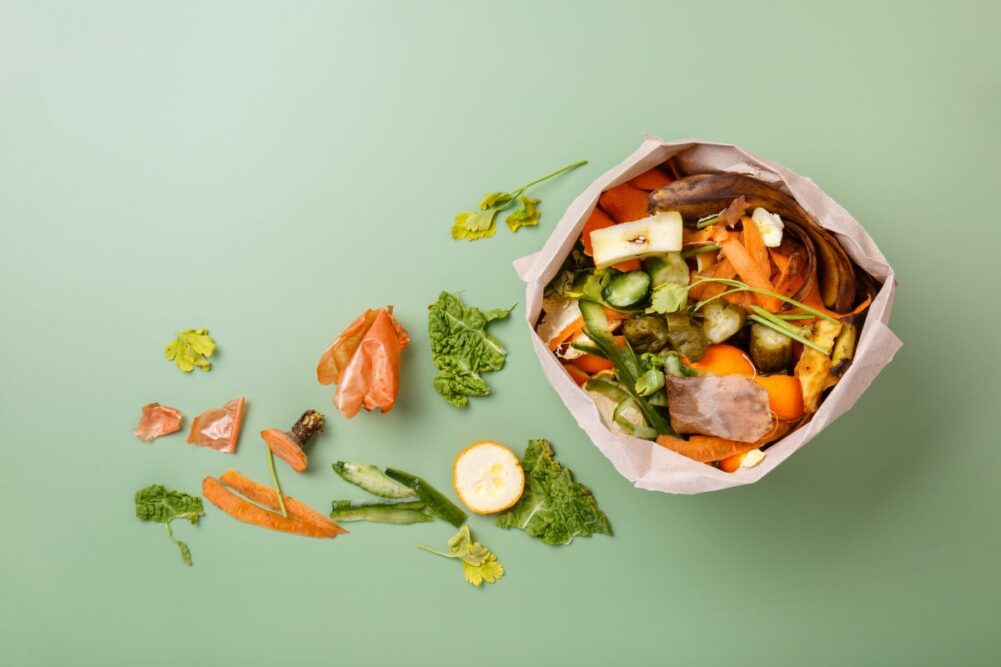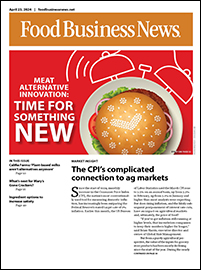KANSAS CITY — Upcycling is becoming more common in food and beverage product development. It’s about creating a circular economy where otherwise discarded food products are turned into products of value, often food ingredients, but sometimes compounds that go into supplements, cosmetics or packaging.
Dairy processors are familiar with upcycling, because the liquid whey produced during cheesemaking was once treated as a byproduct that often went to animal feed. Today, cheese is sometimes produced for the purpose of generating whey, an ingredient that is used to add protein to all types of foods and beverages.
“We have always upcycled in the food ingredients industry, but now we have a name and classification for it,” said Robert Beausire, chief executive officer, CoryPro Ingredients Inc., Niwot, Colo., a startup focused on upcycling the byproducts of guar gum production. “It just makes sense if we can do it economically.”
Upcycling complements the sustainably sourced trend, which 37% of consumers indicated was important in the 2024 Food and Health Survey from the International Food Information Council, Washington, as compared to 31% the previous year. Choosing products formulated with upcycled ingredients is an easy way to make an immediate impact at the point of sale.
The same survey showed that more consumers (30% versus 24%, a year ago) also are looking for compostable packaging. That’s where precycling comes into play.
Precycling enters the conversation
The new “cycle” being added to sustainability efforts is called precycling. It requires taking steps to reduce waste early in a process so there’s less need to upcycle or recycle.
Moosa Nature LLC, Plantation, Fla., is doing this with its new no waste dried fruit tea. The consumer first drinks the tea and then eats the fruit used to steep the tea. The fruits are dried to preserve taste and nutrition. The consumer empties the contents into a mug and adds hot water. After sitting for three minutes, stir, drink and then eat the fruit. Even the packaging is eco-friendly as it is made with sugar cane paper.
Rolling Meadows, Ill.-based Milkadamia has its own approach to addressing sustainability. The company’s new flat pack organic oat milk consists of “printed” sheets of oat milk, which reduce packaging waste by 94% and weight by 85%, according to the company. Each pack contains eight sheets, with one sheet intended to be dissolved in 8 ounces of water. The concept shifts the focus from post-consumer waste management to proactive reduction, said Jim Richards, CEO.
The process involves using a two-dimensional printing process to convert oat milk paste into a shelf-stable edible sheet. The consumer only makes the desired quantity, further reducing waste.
“Shifting the hard work of doing the right thing for the Earth from the consumer to the manufacturer is how we define precycling, with our flat pack,” said Ipek Erdogan-Trinkaus, chief commercial officer at Milkadamia. “It’s a rewarding pursuit to support people who care about making food choices that contribute to a hopeful, abundant future for our planet.”
Suppliers investing in technology
While the concept of precycling is in its infancy, upcycling initiatives continue to advance.
“We are re-imagining how we address the challenge of waste through upcycling, a zero-waste philosophy dedicated to creatively using byproducts from typically discarded side streams, unlocking their highest value and improving the way we use resources,” said Eve Martinet, director-global innovation, IFF, Leiden, the Netherlands. “We are reassessing applications for side-stream materials from manufacturing processes, conducting food waste-reduction pilot projects, commercializing new upcycled ingredients and further developing our pipeline of potential new opportunities.”
The latest addition to IFF’s ingredient range is upcycled rosemary extract. The ingredient improves and extends the taste of beverages, such as flavored waters, seltzers and mocktails, reducing returns and waste. In many instances, it is simply labeled as natural flavor.
“Traditionally, rosemary extraction has focused on yielding oil-soluble, carnosic acid-rich components (for function as a natural antioxidant),” Martinet said. “However, the side stream contains a valuable molecule, rosmarinic acid. IFF has discovered an effective method to utilize this side stream.”
Beausire of CoryPro Ingredients sees an opportunity to use plant resources more wisely, including use in human food rather than as animal feed.
“The guar bean, also known as the cluster bean, produces a high-protein meal that is sold as animal feed, but we have developed technology to process it into flavorless-high protein concentrates and isolates for use as food and nutritional ingredients,” he said. “To us, this is the low-hanging fruit to help meet the protein shortage predicted for 2050.”
While cheese whey upcycling is common practice, when Greek yogurt went mainstream 20 years ago, a new side stream needed to be addressed. Traditional strained Greek yogurt produces a liquid referred to as acid whey and it has posed significant environmental and financial challenges for the dairy industry.
The nutrient-rich byproduct is now being positioned by Arla Foods Ingredients, Videbæk, Denmark, as an ingredient in the dairy market, for products such as protein shakes, meal replacements and desserts. The products are formulated to offer a mild dairy taste and a smooth, creamy texture, while maintaining viscosity and stability throughout their shelf life.
BioPowder, Birkirkara, Malta, works with a variety of agricultural byproducts. One of its latest innovations is turning walnut shells into an abrasive for cleaning systems. On the food ingredients side, the company is focusing on fruit processing side streams.
With olives supplies plentiful in the Mediterranean region where the company is located, BioPowder uses micronization to clean, dry, mill and sieve olive pits, peels and leaves, the side streams of oil production. The result is a range of multi-functional insoluble dietary fiber ingredients with significant levels of polyphenolic compounds.
After olives have been squeezed for their oil, about 85% solid remains, amounting to more than 40 million tons annually. The residual fat in the side stream known as pomace begins to oxidize quickly. Recognizing this challenge, PhenOlives, Beit Shean, HaZafon, Israel, developed a sustainable solution to turn olive oil production waste into nutrient-rich gluten-free flour.
The patented system is installed directly in olive mills. The high-fiber olive flour is rich in antioxidants, offering health benefits similar to olive oil, according to the company.
Comet, Schaumburg, Ill., upcycles a fiber side stream from wheat processing to make a wheat fiber extract.
“Arabinoxylan has laid dormant in plant materials left behind and processed out of our modern food system,” said Loula Merkel, CEO of Comet. ”Arabinoxylan is an exceptional soluble dietary fiber with clinically proven health benefits and superior tolerance in the gut.”
The company initiated a life cycle assessment (LCA) to measure the life cycle carbon emissions for the prebiotic fiber. The findings suggest that wheat fiber extract exhibits a 23 times lower carbon footprint compared to beta-glucan and five times lower than inulin.
Spent grains, a side stream of barley, wheat and rye from beer production, have been upcycled for the past decade by Upcycled Foods Inc., Berkeley, Calif. The company repurposes the grains, turning them into a flour-like product with a toasted appearance, flavor and aroma. The flour provides a minimum of three-and-a-half times the dietary fiber and double the plant protein of whole grain flour, as well as prebiotics, according to the company.
It is currently used in a range of branded and private label bread, pastas and wraps. Atoria’s Family Bakery, Gilroy, Calif., recently introduced the first naan formulated with the ingredient.
Bright Side Snacks, Houston, produces crisps made from upcycled fruit and vegetable pulp.
Imperfect potatoes are the key ingredient in Uglies Kettle Chips, a business of Dieffenbach’s Potato Chips Inc., Womelsdorf, Pa. The company is staying on trend with the rollout of its two newest sweet potato flavors: hot honey and spicy barbecue.
Ocean Spray Ingredients, Middleboro, Mass., upcycles the seeds from its cranberry processing facilities. The ingredient can add color, nutrition and texture to all types of foods.
“Cranberry seeds are a beautiful red hue on the outside, and on the inside are full of fiber, protein, and omega 3 and 6 fatty acids,” said Katy Galle, senior vice president of development and sustainability.
Some suppliers offer technologies to assist food manufacturers with repurposing their side streams. Innophos, Cranbury, NJ, offers an emulsifying system designed to help cheese manufacturers incorporate up to 50% upcycled natural cheese ingredients into processed cheese products that may be formed into blocks, slices or shreds.
“It ensures the same high-quality texture and melt characteristics that consumers expect from traditional processed cheese made without upcycled ingredients,” said Amr Shaheed, manager of technical services and development. “This process maintains quality with less than 10% difference in meltability compared to traditional methods.”
The future of upcycling and precycling is promising. It’s a win-win for all parties.
“We believe that by establishing a verifiable standard for upcycled foods and ingredients, business-to-business and business-to-consumer companies can demonstrate their commitment to sustainability, foster industry accountability and build consumer trust and confidence in upcycled food,” Martinet said. “It removes the burden of educating consumers from individual companies and overall aligns efforts toward a circular economy.”




